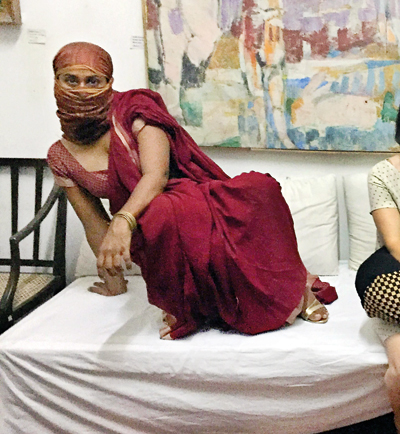Curating critique
We were meant to be looking at her; at the way she moved, slowly striking a pose against an antique chair or mirror, demonstrating the control she held over her sari-clad body. How, hand on hip and leaning into the crowd, she drew focus to the authority of her stance. But it was the way she met our gaze, with her puckish stare only visible through a ninja-like mask, that made it uncomfortable for us to look at her for too long.

Venuri Perera in “See You, See Me’
Venuri Perera’s “See you, See Me” (2018), performed at the opening of the “Em-[body]-ing Power” exhibition this February, upturned the usual dynamic of women, and objects of art, being the ones on display (or for sale). What made this reversal of gaze all the more powerful, however, was the performance’s positioning within a room full of paintings of curvaceous women wearing saris, by George Keyt.
The room was one of many in the Sapumal Foundation; once the home of painter Harold Pieris and the haunt of the modernist ’43 Group,and temporarily the site of this two-day pop-up art exhibition. It was clear that contemporary artworks such as Perera’s, placed in conversation with those from over 50 years ago, such as Keyt’s,were able to activate and engage with the Sapumal’s existing archive in surprising and profound ways.
For example, “See you, See Me” could be viewed as a feminist critique of Keyt’s approach, reclaiming the sari-clad body, from those orientalist and nationalist fantasies. Now, the female subject represented her own sense of self and code of conduct. Just one of the many clever pairings by curators Tamara Fernando and Sandev Handy, it seemed the entire show could be understood through the lens of‘curating critique.’
Angela Dimitrakaki, in her 2013 book Gender, artWork and the global imperative, suggests that the Danish collective Kuratorisk Aktion curates critique, rather than art. It may be useful to consider how the collective’s curatorial approach, which Dimitrakaki says “breaks with institutionally-based curating,” and is often “an intervention in the form of public pedagogy,” resonates with Fernando and Handy’s own in this case.
For example, just as Kuratorisk Aktion’s interventionist pedagogy is positioned as “openly feminist, anti-capitalist, anti-colonialist and queer,” Fernando and Handy’s intervention also questioned notions of intersectionality via an assembly of voices. Pasan Jayasinghe’s idyllic Sri Lankan landscapes, illustrated using soft watercolours and simple outlines in a style similar to children’s storybooks, was exemplary of this.
Closer inspection of these tropical scenes, titled “Indecent Paradise” (2018), revealed that they were populated by many different groups and individuals, including same-sex couples. Foregrounding intimacy and joy, over explicitly sexualised signifiers, Jayasinghe led us to question why this kind of ordinary fantasy still remains such an extraordinary reality. “Queer people are just not able to exist publicly,” he said.
While it may have been obvious to speak about the ambiguous legal position, or the persecution of queer people by the police (particularly in resort towns and beaches in Sri Lanka) the artist shed light on their subtle erasure from everyday life instead. Again, the positioning of this series in the same room as homoerotic portraits by iconic photographer Lionel Wendt, brought about several realizations and discussions.
If Jayasinghe’s series lamented the hidden nature of queer life, Wendt’s photographs were an overt celebration of the personal and private. However, taking another look at the monochromatic, rippled torsos and glimmering, faceless bodies he portrayed, the images seemed to speak more of the man than of the time. How different was life back then for gay men?Also, what of Wendt’s own male gaze and exoticization of the body?
It was reverberating questions like these which made “Em-[body]-ing Power” such a layered and fascinating exhibition. No longer able to be a passive audience in this oft-over looked museum-like space, we were suddenly having to rethink our staid and flattened notions of the’43 Group. Bringing in contemporary anxieties had somehow served to highlight that the historical move toward modernity and tradition had been fraught with complexity and flaws.
Splicing the modern identity open with his very postmodern deconstruction of self was photographer Abdul Halik Azeez. Placed in an area usually used to display Harold Pieris’s paintbrushes, the quintessential sign of the artist, Azeez’s installation,“Myself” (2018), repurposed one of Pieris’s tables to display passport photographs, sketches, selfies, receipts, diary excerpts, a zine and a toothbrush instead.
Azeez started taking photographs of himself just over a year ago, as he became increasingly troubled by the reductive labels that “capitalist society and a post-9/11 world”imposed on him, both when he travelled and at home. This curatorial context allowed Azeez to push his conceptual practice, use different media, and explore the construction of his identity through presenting multiple, partial reflections of himself.
In creating a unique and autonomous exhibition platform that was not reliant upon state funding or corporate agendas, Fernando and Handy gave artists such as Azeez, Jayasinghe and Perera the space to produce unconstrained proposals, and the time to distil these ideas down into tightly curated artworks. As Dimitrikaki describes, this kind of curatorial approach can hone in on the most critical of narratives and allow for socially transformative action.
Fernando and Handy did not prompt conversations on the body to turn toward gender, queerness and capital, rather they sensitively tuned into frequencies already being emitted by a current crop of artists. Ultimately, it was the way they astutely brought the old avant-garde together with the new, through a polyphony of perspectives on the body as a site of identity and power and created meaningful linkages across time, from pre-colonial to post-conflict, that made this exhibition truly stand apart.


